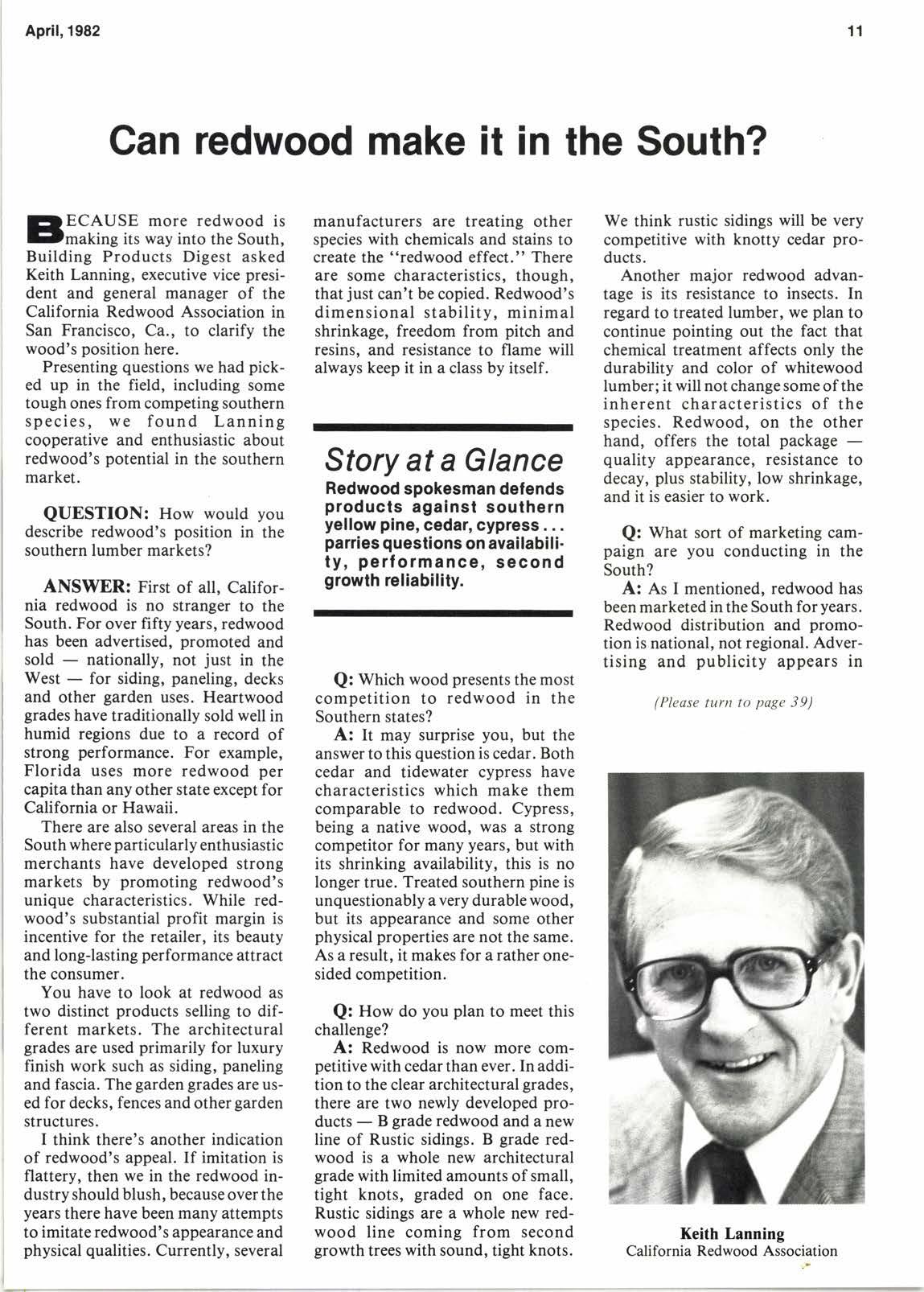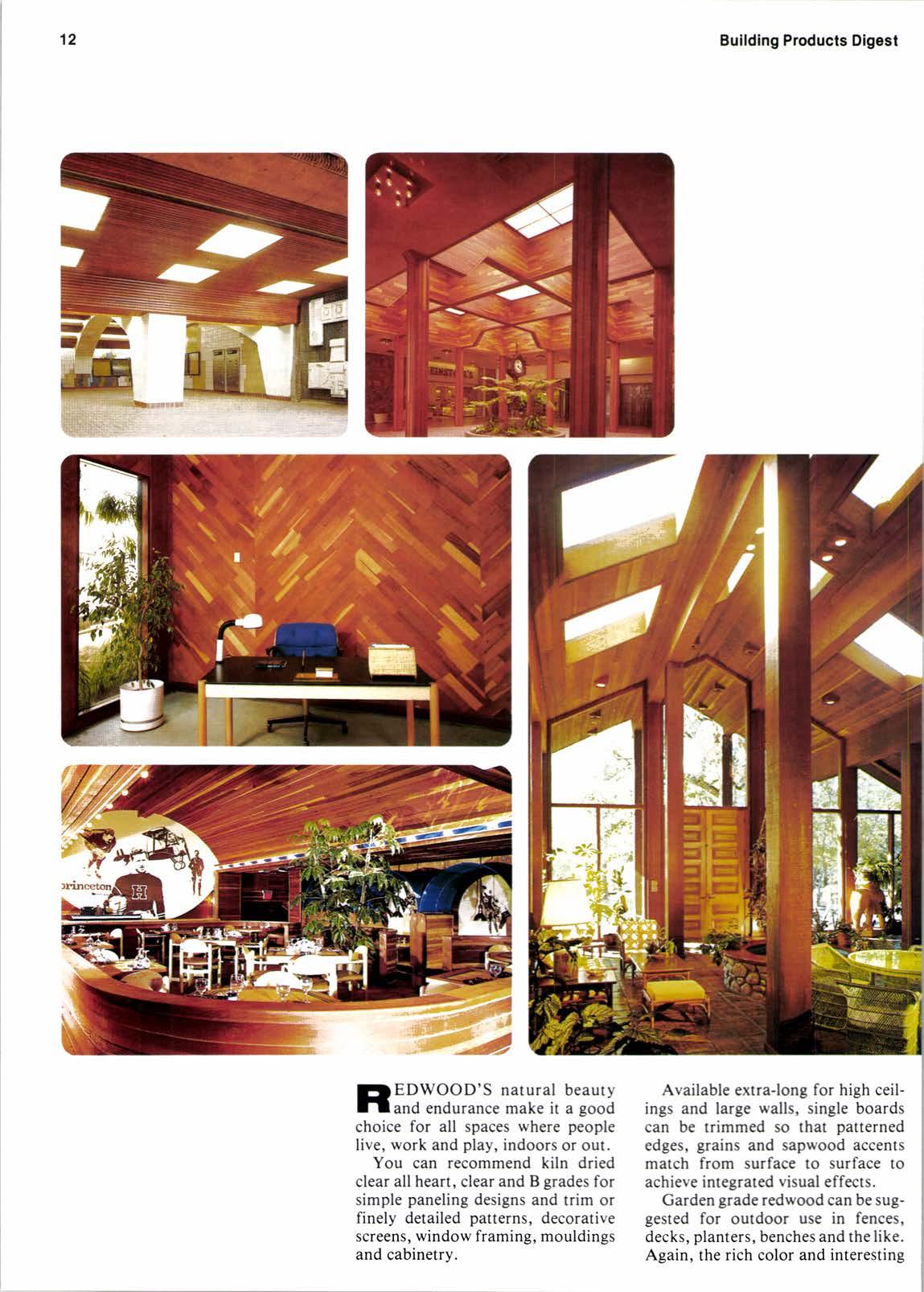
3 minute read
Can redwood make it in the South?
TTECAUSE more redwood is Elmaking its way into the South, Building Products Digest asked Keith Lanning, executive vice president and general manager of the California Redwood Association in San Francisco, Ca., to clarify the wood's position here.
Presenting questions we had picked up in the field, including some tough ones from competing southern species, we found Lanning cooperative and enthusiastic about redwood's potential in the southern market.
QUESTION: How would you describe redwood's position in the southern lumber markets?
ANSWER: First of all, California redwood is no stranger to the South. For over fifty years, redwood has been advertised, promoted and sold - nationally, not just in the Westfor siding, paneling, decks and other garden uses. Heartwood grades have traditionally sold well in humid regions due to a record of strong performance. For example, Florida uses more redwood per capita than any other state except for California or Hawaii.
There are also several areas in the South where particularly enthusiastic merchants have developed strong markets by promoting redwood's unique characteristics. While redwood's substantial profit margin is incentive for the retailer, its beauty and longJasting performance attract the consumer.
You have to look at redwood as two distinct products selling to different markets. The architectural grades are used primarily for luxury finish work such as siding, paneling and fascia. The garden grades are used for decks, fences and other garden structures.
I think there's another indication of redwood's appeal. If imitation is flattery, then we in the redwood industry should blush, because over the years there have been many attempts to imitate redwood's appearance and physical qualities. Currently, several manufacturers are treating other species with chemicals and stains to create the "redwood effect." There are some characteristics, though, that just can't be copied. Redwood's dimensional stability, minimal shrinkage, freedom from pitch and resins, and resistance to flame will always keep it in a class by itself.
Sfory at a Glance
Redwood spokesman defends products agalnst southern yellow pine, cedar, cypress. parraes questions on availabality, performance, second growth reliabillty.
Q: Which wood presents the most competition to redwood in the Southern states?
A: It may surprise you, but the answer to this question is cedar. Both cedar and tidewater cypress have characteristics which make them comparable to redwood. Cypress, being a native wood, was a strong competitor for many years, but with its shrinking availability, this is no longer true. Treated southern pine is unquestionably a very durable wood, but its appearance and some other physical properties are not the same. As a result, it makes for a rather onesided competition.
Q: How do you plan to meet this challenge?
A: Redwood is now more competitive with cedar than ever. In addition to the clear architectural grades, there are two newly developed productsB grade redwood and a new line of Rustic sidings. B grade redwood is a whole new architectural grade with limited amounts of small, tight knots, graded on one face. Rustic sidings are a whole new redwood line coming from second growth trees with sound, tight knots.
We think rustic sidings will be competitive with knotty cedar ducts.
very pro-
Another major redwood advantage is its resistance to insects. In regard to treated lumber, we plan to continue pointing out the fact that chemical treatment affects only the durability and color of whitewood lumber; it will not change some of the inherent characteristics of the species. Redwood, on the other hand, offers the total package - quality appearance, resistance to decay, plus stability, low shrinkage, and it is easier to work.
Q: What sort of marketing campaign are you conducting in the South?
A: As I mentioned, redwood has been marketed in the South for years. Redwood distribution and promotion is national, not regional. Advertising and publicity appears in
(Please turn to page 39)
EEDWOOD'S natural beauty fland endurance make it a good choice for all spaces where people live, work and play, indoors or out. You can recommend kiln dried clear all heart, clear and B grades for simple paneling designs and trim or finely detailed patterns, decorative screens, window framing, mouldings and cabinetry.
Available extra-long for high ceilings and large walls, single boards can be trimmed so that patterned edges, grains and sapwood accents match from surface to surface to achieve integrated visual effects.
Garden grade redwood can be suggested for outdoor use in fences, decks, planters, benches and the like. Again, the rich color and interesting











